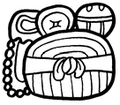| Dark Sun (Nunoom Che'en?) | |
|---|---|
| Ajaw | |
 Dark Sun's portrait on Stela 24 | |
| King of Tikal | |
| Reign | c. 810 |
| Predecessor | Nuun Ujol K'inich |
| Successor | Jewel K'awiil |
| Died | Tikal |
| Father | Nuun Ujol K'inich (possibly) |
| Religion | Maya religion |
| Signature |  |
Dark Sun [N 1] (fl. 810), was an ajaw of the Maya city of Tikal. He ruled c. 810 and was probably the son of Nuun Ujol K'inich. The monuments associated with Dark Sun are: Stela 24; Altar 7; Temple 3 Lintel 2?. [1]
